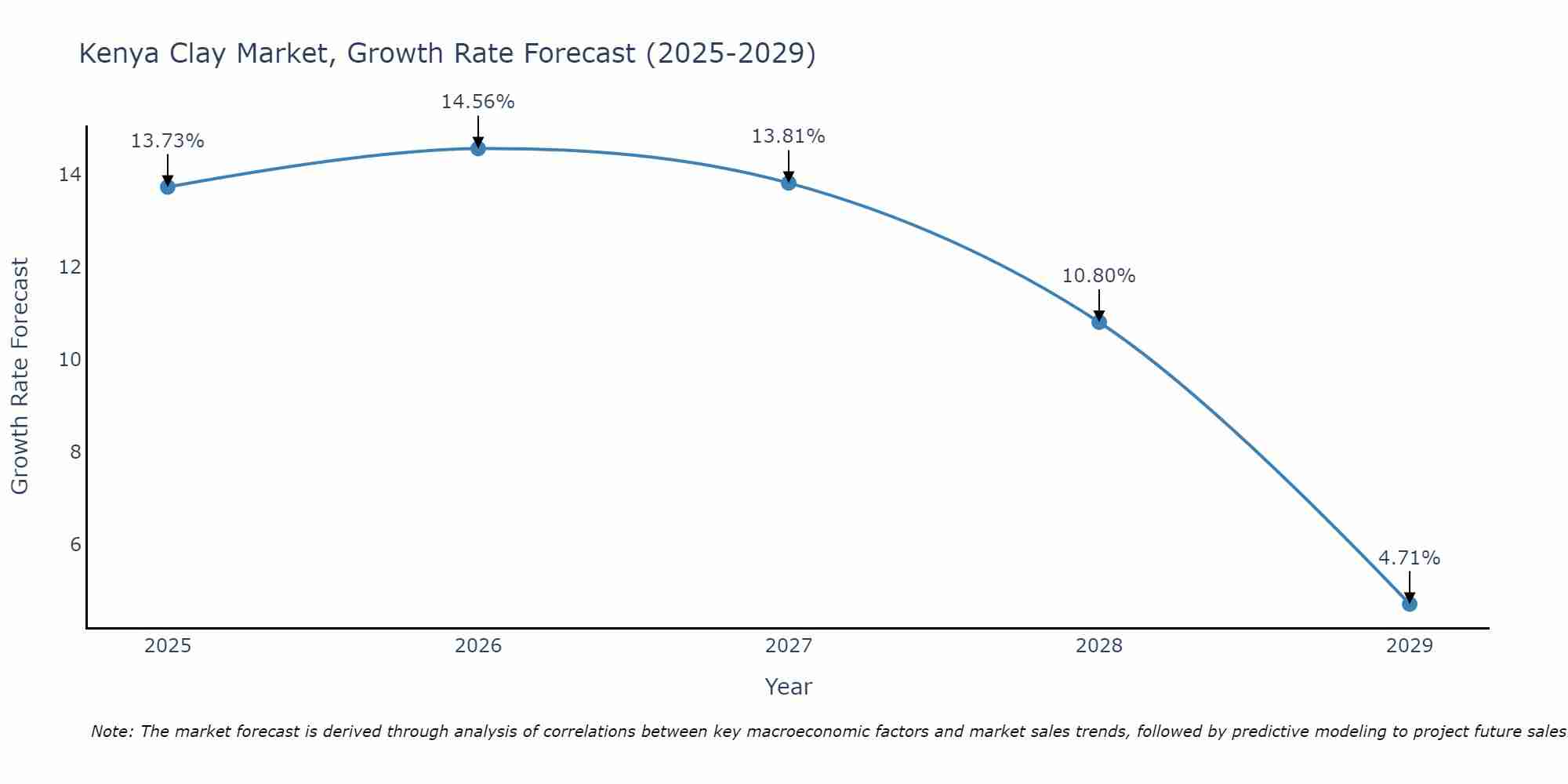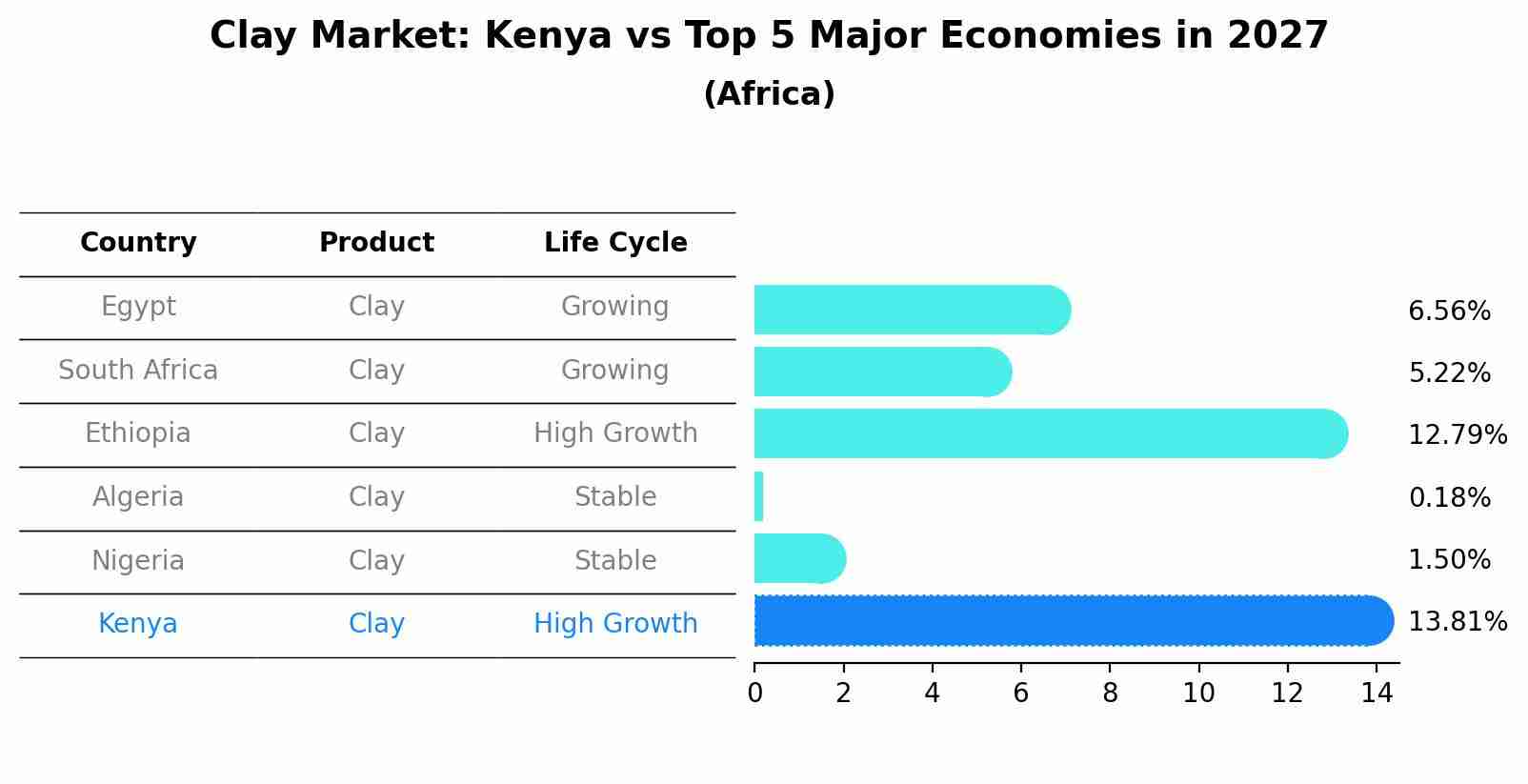Kenya Clay Market Outlook | Revenue, Share, Industry, Forecast, Companies, Value, COVID-19 IMPACT, Growth, Size, Trends & Analysis
| Product Code: ETC319010 | Publication Date: Aug 2022 | Updated Date: Aug 2025 | Product Type: Market Research Report | |
| Publisher: 6Wresearch | No. of Pages: 75 | No. of Figures: 35 | No. of Tables: 20 | |
Kenya Clay Market Size Growth Rate
The Kenya Clay Market is projected to witness mixed growth rate patterns during 2025 to 2029. Starting at 13.73% in 2025, the market peaks at 14.56% in 2026, and settles at 4.71% by 2029.

Clay Market: Kenya vs Top 5 Major Economies in 2027 (Africa)
By 2027, the Clay market in Kenya is anticipated to reach a growth rate of 13.81%, as part of an increasingly competitive Africa region, where Egypt remains at the forefront, supported by South Africa, Ethiopia, Algeria and Nigeria, driving innovations and market adoption across sectors.

Kenya Clay Market Overview
Kenya clay market is significant, with clay being utilized in various industries such as construction, ceramics, and pharmaceuticals. Clay is used in construction for making bricks, tiles, and ceramics for sanitaryware and tableware production. The market`s growth is driven by infrastructure development projects, urbanization, and the demand for affordable housing solutions.
Drivers of the market
The Kenya clay market is primarily influenced by the construction, ceramics, and pottery industries. Clay serves as a fundamental raw material for manufacturing bricks, tiles, sanitaryware, and pottery products. The construction sector`s growth, driven by infrastructure development projects and urbanization, drives the demand for clay-based building materials. Moreover, the ceramics and pottery industries rely on high-quality clay for producing decorative and functional items, further supporting market growth.
Challenges of the market
Kenya clay market faces challenges such as inconsistent quality of clay deposits and limited technological advancements in processing methods. Environmental regulations regarding mining also impact the industry.
Government Policy of the market
The government may implement policies to promote sustainable clay mining practices, regulate land use in clay-rich areas, and support local clay processing industries. Regulations aim to prevent environmental degradation, ensure fair resource distribution, and promote value addition in the clay market.
Key Highlights of the Report:
- Kenya Clay Market Outlook
- Market Size of Kenya Clay Market, 2021
- Forecast of Kenya Clay Market, 2028
- Historical Data and Forecast of Kenya Clay Revenues & Volume for the Period 2018 - 2028
- Kenya Clay Market Trend Evolution
- Kenya Clay Market Drivers and Challenges
- Kenya Clay Price Trends
- Kenya Clay Porter's Five Forces
- Kenya Clay Industry Life Cycle
- Historical Data and Forecast of Kenya Clay Market Revenues & Volume By Application for the Period 2018 - 2028
- Historical Data and Forecast of Kenya Clay Market Revenues & Volume By Tableware for the Period 2018 - 2028
- Historical Data and Forecast of Kenya Clay Market Revenues & Volume By Sanitary ware for the Period 2018 - 2028
- Historical Data and Forecast of Kenya Clay Market Revenues & Volume By Medical applications for the Period 2018 - 2028
- Historical Data and Forecast of Kenya Clay Market Revenues & Volume By End Use for the Period 2018 - 2028
- Historical Data and Forecast of Kenya Clay Market Revenues & Volume By Ceramic and for the Period 2018 - 2028
- Historical Data and Forecast of Kenya Clay Market Revenues & Volume By Non-ceramic for the Period 2018 - 2028
- Kenya Clay Import Export Trade Statistics
- Market Opportunity Assessment By Application
- Market Opportunity Assessment By End Use
- Kenya Clay Top Companies Market Share
- Kenya Clay Competitive Benchmarking By Technical and Operational Parameters
- Kenya Clay Company Profiles
- Kenya Clay Key Strategic Recommendations
Frequently Asked Questions About the Market Study (FAQs):
1 Executive Summary |
2 Introduction |
2.1 Key Highlights of the Report |
2.2 Report Description |
2.3 Market Scope & Segmentation |
2.4 Research Methodology |
2.5 Assumptions |
3 Kenya Clay Market Overview |
3.1 Kenya Country Macro Economic Indicators |
3.2 Kenya Clay Market Revenues & Volume, 2021 & 2028F |
3.3 Kenya Clay Market - Industry Life Cycle |
3.4 Kenya Clay Market - Porter's Five Forces |
3.5 Kenya Clay Market Revenues & Volume Share, By Application, 2021 & 2028F |
3.6 Kenya Clay Market Revenues & Volume Share, By End Use, 2021 & 2028F |
4 Kenya Clay Market Dynamics |
4.1 Impact Analysis |
4.2 Market Drivers |
4.2.1 Increasing infrastructure development projects in Kenya driving demand for clay products |
4.2.2 Growing construction industry in the region boosting the consumption of clay for bricks, tiles, and sanitaryware |
4.2.3 Rising government investments in urbanization projects fueling the demand for clay-based products |
4.3 Market Restraints |
4.3.1 Fluctuating prices of raw materials impacting the production cost and profitability of clay products |
4.3.2 Competition from alternative materials like concrete, steel, and composites posing a challenge to the clay market |
4.3.3 Environmental concerns and regulations regarding clay mining and processing affecting the industry operations |
5 Kenya Clay Market Trends |
6 Kenya Clay Market, By Types |
6.1 Kenya Clay Market, By Application |
6.1.1 Overview and Analysis |
6.1.2 Kenya Clay Market Revenues & Volume, By Application, 2018 - 2028F |
6.1.3 Kenya Clay Market Revenues & Volume, By Tableware, 2018 - 2028F |
6.1.4 Kenya Clay Market Revenues & Volume, By Sanitary ware, 2018 - 2028F |
6.1.5 Kenya Clay Market Revenues & Volume, By Medical applications, 2018 - 2028F |
6.2 Kenya Clay Market, By End Use |
6.2.1 Overview and Analysis |
6.2.2 Kenya Clay Market Revenues & Volume, By Ceramic and, 2018 - 2028F |
6.2.3 Kenya Clay Market Revenues & Volume, By Non-ceramic, 2018 - 2028F |
7 Kenya Clay Market Import-Export Trade Statistics |
7.1 Kenya Clay Market Export to Major Countries |
7.2 Kenya Clay Market Imports from Major Countries |
8 Kenya Clay Market Key Performance Indicators |
8.1 Number of infrastructure projects initiated or completed in Kenya |
8.2 Percentage increase in construction sector output in the region |
8.3 Adoption rate of sustainable practices in clay mining and processing industry |
8.4 Investment in research and development for innovative clay products |
8.5 Percentage growth in export of clay-based products from Kenya |
9 Kenya Clay Market - Opportunity Assessment |
9.1 Kenya Clay Market Opportunity Assessment, By Application, 2021 & 2028F |
9.2 Kenya Clay Market Opportunity Assessment, By End Use, 2021 & 2028F |
10 Kenya Clay Market - Competitive Landscape |
10.1 Kenya Clay Market Revenue Share, By Companies, 2021 |
10.2 Kenya Clay Market Competitive Benchmarking, By Operating and Technical Parameters |
11 Company Profiles |
12 Recommendations |
13 Disclaimer |
- Single User License$ 1,995
- Department License$ 2,400
- Site License$ 3,120
- Global License$ 3,795
Search
Related Reports
- ASEAN and Thailand Brain Health Supplements Market (2025-2031) | Strategy, Consumer Insights, Analysis, Investment Trends, Opportunities, Growth, Size, Share, Industry, Revenue, Segments, Value, Segmentation, Supply, Forecast, Restraints, Outlook, Competition, Drivers, Trends, Demand, Pricing Analysis, Competitive, Strategic Insights, Companies, Challenges
- ASEAN Bearings Market (2025-2031) | Strategy, Consumer Insights, Analysis, Investment Trends, Opportunities, Growth, Size, Share, Industry, Revenue, Segments, Value, Segmentation, Supply, Forecast, Restraints, Outlook, Competition, Drivers, Trends, Demand, Pricing Analysis, Competitive, Strategic Insights, Companies, Challenges
- Europe Flooring Market (2025-2031) | Outlook, Share, Industry, Trends, Forecast, Companies, Revenue, Size, Analysis, Growth & Value
- Saudi Arabia Manlift Market (2025-2031) | Outlook, Size, Growth, Trends, Companies, Industry, Revenue, Value, Share, Forecast & Analysis
- Uganda Excavator, Crane, and Wheel Loaders Market (2025-2031) | Strategy, Consumer Insights, Analysis, Investment Trends, Opportunities, Growth, Size, Share, Industry, Revenue, Segments, Value, Segmentation, Supply, Forecast, Restraints, Outlook, Competition, Drivers, Trends, Demand, Pricing Analysis, Competitive, Strategic Insights, Companies, Challenges
- Rwanda Excavator, Crane, and Wheel Loaders Market (2025-2031) | Strategy, Consumer Insights, Analysis, Investment Trends, Opportunities, Growth, Size, Share, Industry, Revenue, Segments, Value, Segmentation, Supply, Forecast, Restraints, Outlook, Competition, Drivers, Trends, Demand, Pricing Analysis, Competitive, Strategic Insights, Companies, Challenges
- Kenya Excavator, Crane, and Wheel Loaders Market (2025-2031) | Strategy, Consumer Insights, Analysis, Investment Trends, Opportunities, Growth, Size, Share, Industry, Revenue, Segments, Value, Segmentation, Supply, Forecast, Restraints, Outlook, Competition, Drivers, Trends, Demand, Pricing Analysis, Competitive, Strategic Insights, Companies, Challenges
- Angola Excavator, Crane, and Wheel Loaders Market (2025-2031) | Strategy, Consumer Insights, Analysis, Investment Trends, Opportunities, Growth, Size, Share, Industry, Revenue, Segments, Value, Segmentation, Supply, Forecast, Restraints, Outlook, Competition, Drivers, Trends, Demand, Pricing Analysis, Competitive, Strategic Insights, Companies, Challenges
- Israel Intelligent Transport System Market (2025-2031) | Strategy, Consumer Insights, Analysis, Investment Trends, Opportunities, Growth, Size, Share, Industry, Revenue, Segments, Value, Segmentation, Supply, Forecast, Restraints, Outlook, Competition, Drivers, Trends, Demand, Pricing Analysis, Competitive, Strategic Insights, Companies, Challenges
- Uganda Precast and Aggregate Market (2025-2031) | Strategy, Consumer Insights, Analysis, Investment Trends, Opportunities, Growth, Size, Share, Industry, Revenue, Segments, Value, Segmentation, Supply, Forecast, Restraints, Outlook, Competition, Drivers, Trends, Demand, Pricing Analysis, Competitive, Strategic Insights, Companies, Challenges
Industry Events and Analyst Meet
Our Clients
Whitepaper
- Middle East & Africa Commercial Security Market Click here to view more.
- Middle East & Africa Fire Safety Systems & Equipment Market Click here to view more.
- GCC Drone Market Click here to view more.
- Middle East Lighting Fixture Market Click here to view more.
- GCC Physical & Perimeter Security Market Click here to view more.
6WResearch In News
- Doha a strategic location for EV manufacturing hub: IPA Qatar
- Demand for luxury TVs surging in the GCC, says Samsung
- Empowering Growth: The Thriving Journey of Bangladesh’s Cable Industry
- Demand for luxury TVs surging in the GCC, says Samsung
- Video call with a traditional healer? Once unthinkable, it’s now common in South Africa
- Intelligent Buildings To Smooth GCC’s Path To Net Zero













